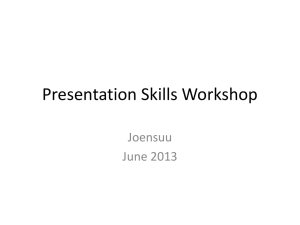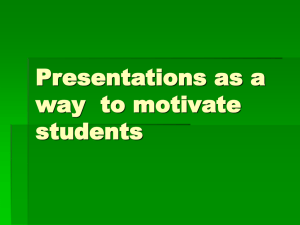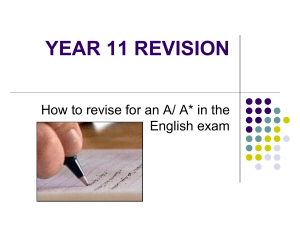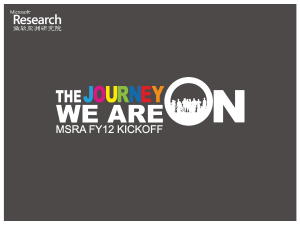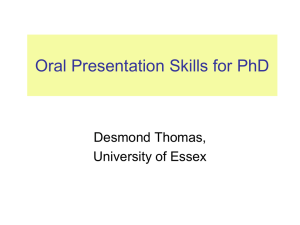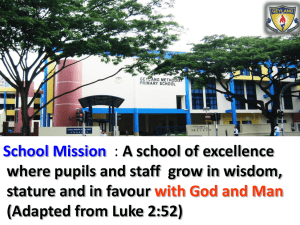Power Point - The Nierenberg Group
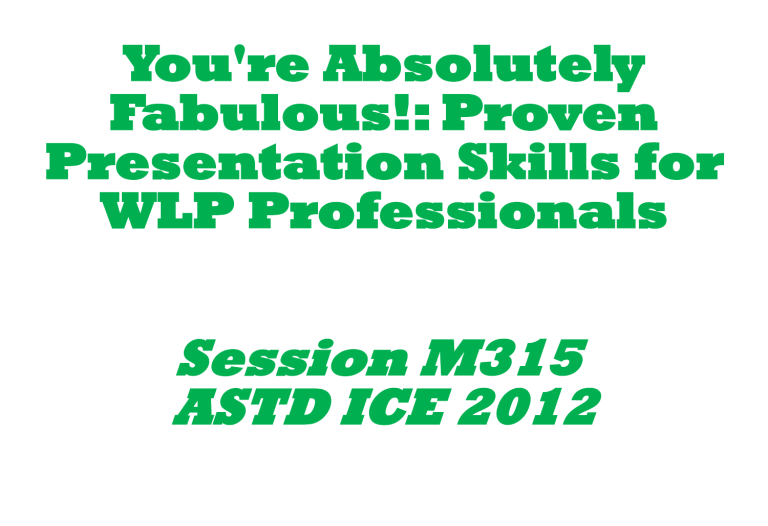
You're Absolutely
Fabulous!: Proven
Presentation Skills for
WLP Professionals
Session M315
ASTD ICE 2012
Welcome!
Our Expectations
• Engage and Participate
• Ask Questions
• Take away at least one item (tip, thought, action item, network contact, etc.)
Our Learning Objectives
Identify the five key components of a wellstructured presentation
Create 2 or 3 presentation improvement goals that can be met within 30 days.
Today’s Topics
• What is a Presentation?
• The 5 Key Components of a Presentation
• Professional
Preparation
• Content Preparation
• Performance Skills
• Asking Questions
• Summary & Closing
Ice-breaker Exercise
Turn to your neighbor and answer the following questions:
1. In exactly 7 words, describe what you do, without using “I,”
“we,” or the name of your company. This is an opportunity to create your own headline -- a conversation starter to begin with a VERB or ACTION OPPORTUNITY.
2. In what communication situations are you most comfortable
(i.e., discussions, public speaking, formal presentations, interviews, one-on-one discussions, parties, family gatherings, etc.)?
3. In what communication situations are you un-comfortable?
Today’s Topic 1:
What is a
Presentation?
Any kind of presentation is…
“… the act of working to change the content of another person’s mind at a particular time and place. By adopting the philosophy that presentations can happen anytime, anywhere, you open up a whole world of presentation possibilities.”
Presenting Learning. Bingham, Tony, and Tony
Jeary. Alexandria, VA: ASTD Press, 2007 (pp.18-
19)
Types of Presentations
• Formal training sessions & seminars
• Speeches
• Sales presentations
• Facilitated events
(workshops, team meetings, etc.)
• One-on-ones (in-person or virtual)
• Electronic presentations
(Faxes, emails, WebEx,
Skype, PowerPoint)
• Branding messages
Consistency of Our Communications
All of our presentations = a series of linked messages used to create consistent communications, leading to a greater chance of our desired results being fulfilled.
Today’s Topic 2:
The Key
Components of a
Presentation
The Five Key Components of Any
Presentation
Clearly-identified Subject & Agenda
Preparation & Audience Analysis
Hook, Grabber, Close, and Call to Action
Body with 3 Content Blocks
Summary with Key Take-away Points
Hook Subject
Agenda
Point 2
Grabbe r
Point 1 Point 3
Block 1
Data
Statistics
Personal
Experience
Anecdotes
Facts
Evidence
Analogy
Key Take
Away Point 1
Body
Block 2
Data
Statistics
Personal Experience
Anecdotes
Facts
Analogy
Key Take
Away Point 2
Close. Call to action!
Block 3
Data
Statistics
Personal
Experience
Anecdotes
Facts
Evidence
Analogy
Key Take
Away Point 3
Keeping It Basic
•
Tell them what you are going to tell them
1
• Tell them.
2.
2
3.
• Tell them what you told them
3
Today’s Topic 3:
Professional
Preparation
Addressing the Audience Needs
Fully answering key questions regarding your audience will facilitate effective preparation, and thus ensure an effective, award-worthy presentation.
Addressing the Audience Needs
Do I know this audience and what it wants and needs to hear?
• What are the demographics?
• What are the audience’s concerns, issues, hopes and expectations?
• Are they prisoners or eager participants in my session?
• Are they experts on my topic, or new to it?
• What’s the climate of their organization?
• What kind of news have they had?
Four Key Things Your Audience Wants
• To Be Interested. Get their attention Fast ---and keep it!
• Benefits. (WIIFM) Make it the easy Listening station…
• Information that’s needed and can be used immediately..not
Too Much nor not Too Little
• To Be Educated and changed by your presentation
Exercise: Digging Deeper to Know
Your Audience
• In groups of 2-4 people, take 5 minutes to brainstorm a list of questions you would to answer regarding the audience of a typical presentation. Ideally, these would all be answers you’d gather in your preparation phase.
• At the cue of your facilitator, take 30 seconds to select someone to share your list with the full group.
Sample Audience Questions
• Who are they?
• How were they selected to be participants?
• How many will be attending?
• How much do they know about the topic?
• Are they friendly or hostile to your presentation?
• Where have they gotten their information?
• What information do they want and need?
• What attitude might your listeners have toward you, your subject, and your organization?
• What ideas, feelings, experiences do you share with them?
Audience Analysis
Going from the bottom up
Quick Tip: Make Your 1 st Impact in the First 90 Seconds
Idea Exchange
Disagreement is OK!
Stay open and value the connection w/the other person.
Today’s Topic 4:
Content
Preparation
5 Building Blocks for Preparing Content
Establish Purpose
• Inform
• Convince
• Entertain
• Educate
5 Building Blocks for Preparing Content
Select an Opening Statement, focusing on the Central Theme
• Use interesting facts and statistics.
• Give examples or relate a pertinent story.
• Use effective quotations.
• Pose relevant questions.
• Give a demonstration or use an exhibit.
5 Building Blocks for Preparing
Content
Gather Material
• Speak to people who are knowledgeable about your subject.
• Research the topic.
• Write down anything that’s pertinent to your experiences and ideas.
• Assemble all your materials before you write your
presentation.
5 Building Blocks for Preparing
Content
Arrange the Body of Your Speech Logically
• Pose challenge, then offer a solution.
• Make a point, then support it with an example or a statistic or a quote.
• Make comparisons and use emotional appeals.
5 Building Blocks for Preparing Content
Plan the Conclusion Carefully
• It should recapitulate the main idea, remind the audience of the key points, and produce a dramatic and memorable effect.
Building Blocks of Self Marketing
Hook Subject Grabber
Agenda
Point 1 Point 3
Block 1
Data
Statistics
Personal Experience
Anecdotes
Facts
Evidence
Analogy
Point 2
Body
Block 2
Data
Statistics
Personal Experience
Anecdotes
Facts
Evidence
Analogy
Summary
Block 3
Data
Statistics
Personal Experience
Anecdotes
Facts
Evidence
Analogy
Key Take Away Point 1 Key Take Away Point 2 Key Take Away Point 3
Close. Call to action!
The Five Key Components of Any
Presentation
Clearly-identified Subject & Agenda
Preparation & Audience Analysis
Hook, Grabber, Close, and Call to Action
Body with 3 Content Blocks
Summary with Key Take-away Points
Content Preparation Exercise
(Find the Instruction Sheet in your Hand-out Package)
Today’s Topic #5:
Performance Skills
Poise
Style
Personal
Performance
Ease
Conquering nerves
What Your Audience Detects….
• Visual Impressions: Appearance, grooming, positive energy
• Voice Projection: Vocal quality, tone, pace
• Body Language: Demeanor, gestures, carriage, facial expressions
• Public Speaking: Preparation, intention, passion, embraced nervousness
• Manners: Professionalism, social diplomacy
• Non-Verbal Signals: Eye contact, handshakes, spatial relationships, likeability
• Confidence: Esteem of self and others, trust
Source: Management Institute of
Technology
Elements of Effective Oral
Communication
• Voice – Be pleasant to listen to.
• Enunciation – Be clear and concise.
• Modulation – Vary the pitch speed and volume.
• Appearance – Be professional.
• Body Language –appropriate gestures and facial expressions
• Posture –convey confidence
Body Language
• Illustrate
A good gesture can:
• Emphasize
• Strengthen
• Clarify
Visual Aids
Talk to group
Use pointers minimally
YOU are the visual
Simplicity is the art of sophistication
Consistent readability
Performance Skills: Poise & Stature
Get Ready
• Release energy, relieve tension
• Arrive early
• Introduce yourself to meet the audience as individuals
• Remember the “right” handshake
Performance Skills: Poise & Stature
Get Set
• Channel nervousness to positive energy
• Have good posture and stand tall
• Remember that your visual impression can enhance or detract
Performance Skills: Poise & Stature
GO!
• Communicate one-on-one
• Maintain eye contact
• Focus for 3-5 seconds
• Speak slowly and clearly
• Watch “word crutches”
A Successful Presenter
Demonstrates Control of:
Delivery
Gestures
Eye contact
Voice
Time & organization
Skill
Attitude
Practice
Cycle of
Success
Knowledge
Audio-Visual Exercise
Today’s Topic #6:
Asking
Questions
Q&A =
Opportunity
Restate your objective
Control Audience
Enhance Credibility
Demonstrate Leadership
Handling Q&A
Anticipate questions
Ask for questions/raise hand
If no questions, pose one to audience
Listen to entire question
Paraphrase in positive form
Reply simply & directly
Handling Q&A
Break eye contact with questioner
Take questions from entire audience
Do not say “That’s a good question”
Be able to say “I don’t know”
Avoid hypothetical questions
Summary & Closing Comments
The Five Key Components of Any
Presentation
Clearly-identified Subject & Agenda
Preparation & Audience Analysis
Hook, Grabber, Close, and Call to Action
Body with 3 Content Blocks
Summary with Key Take-away Points
Our Learning Objectives
Identify the five key components of a wellstructured presentation
Create 2 or 3 presentation improvement goals that can be met within 30 days.
Today’s Topics
• What is a Presentation?
• The 5 Key Components of a Presentation
• Professional
Preparation
• Content Preparation
• Performance Skills
• Asking Questions
Closing Exercise, Part 1
• Locate the “AHAS” page in your hand-out (page
9).
• Take 5-7 minutes to list a few take-away items
(“AHA” moments) from today’s workshop that are particularly meaningful or helpful to you.
Closing Exercise, Part 2
• Find the page in your hand-out package labeled “Action Plan”
(page 10).
• Start drafting some
Action Plans in the next
5-7 minutes.
